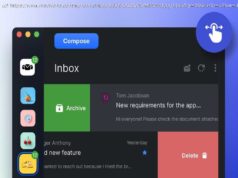Find out how Samsung’s new flagship phone for 2017 is even better than last year’s model. Read our in-depth Galaxy S8 review.
By
Chris Martin | 20 mins ago
See full specs
£689
Price comparision from, and manufacturers
It kept us waiting a little longer than in previous years, but in March Samsung finally rewarded our patience with the Galaxy S8 and Galaxy S8+. These smartphones then went on sale in April as the best phones of 2017 to date.
Now the Galaxy S7 was already a pretty decent phone — in fact Samsung has won the crown in our best smartphones chart for the past three years running. Is it too much to ask for the company to improve on an already good thing?
Well, yes and no. Because the Galaxy S8 is a fantastic flagship, but it’s not flawless. It’s also facing stiff competition from the brand-new OnePlus 5, and not before long it will also have to stand up to the iPhone 8.
New Samsung rumours: Samsung Galaxy S9 | Samsung Galaxy S8 mini | Galaxy S8 Active | Galaxy Note 8 | Bixby speaker
The Galaxy S8 isn’t as expensive as some feared, costing £689 with the Plus model costing an extra £90. That’s still pretty pricey, though, and a fair chunk more than the Galaxy S7, which launched at £569.
You can order the S8 directly from Samsung or Carphone Warehouse. You can also order it on contract from as little as £37.99 per month from EE, Vodafone and O2 (through Carphone Warehouse) or from Three .
EE also exclusively stocks an Arctic Silver version .
We’ve also put together a full guide on where to buy the Galaxy S8.
It’s good to see more in the box than most phones including two USB-C adapters (one to full size USB and the other to Micro-USB) and a pair of AKG headphones with extra tips.
If the Galaxy S7 was stunning in design then we’re not exactly sure how to describe the Galaxy S8 apart from that it’s on another level. It makes its predecessor, and other phones, look dated.
Samsung has brought its edge-screen technology to both phones this year so you don’t need to buy the larger Galaxy S8 Plus to get the full experience. This not only looks great but has a big advantage when it comes to keeping the size of the phone from getting out of control.
The S8 is pretty much the same width, thickness and weight compared to its predecessor. It’s just a few millimetres taller but jumps from 5.1- to 5.8in when it comes to screen size. So what would typically be an unwieldy device feels barely any different in the hand.
It’s a really impressive piece of craftsmanship largely down to significantly reducing the bezels at the top and bottom. A screen-to-body ratio of over 83 percent is impressive stuff.
The physical home button and accompanying capacitive keys are gone to achieve this. Now you have onscreen navigation and a pressure-sensitive home button built into the display — we’ll talk about this more later.
The fingerprint scanner is now on the back, but awkwardly placed next to the camera rather than below it. Right-handed users are likely to smudge the camera when using it. This is our main bugbear in terms of the design and it should really be below the camera, despite creating an unsymmetrical look. Also see: Samsung Pay is now available in the UK!
Many users will be pleased to hear that Samsung has retained the headphone jack on the bottom. The Galaxy S8 is made from a lot of glass once again so it’s a little slippery, but has a Gorilla Glass 5 back to resist damage. You’ll probably want to get a case to protect this expensive slab of metal and glass, though, which is a shame considering the outstanding design. Check out the best Galaxy S8 cases.
As you’d expect the Galaxy S8 is fully dust and waterproof like its predecessor so has an IP68 rating. That extra button you see on the left side of the phone is to quickly launch Bixby, Samsung’s artificial intelligence assistance -see the software section for more on this.
There are five colours to choose from but in the UK we got just three at launch: Midnight Black, Orchid Grey and Arctic Silver (the latter an EE exclusive) . Samsung may well bring the blue and gold options at the later date, but we’ll have to wait and see.
Compared to the Galaxy S7, the new Galaxy S8 isn’ t dramatically different when it comes to the specs and hardware inside. That’s partly because the S7 already ticked a lot of boxes, but there are new components with the screen being the most obvious and impactful change.
As mentioned in the design section, Samsung has impressively jumped from 5.1- to 5.8in when it comes to screen size. This is despite the phone only being a little taller in shape. If that’s not big enough, the Galaxy S8 Plus is a whopping 6.2in.
Like the LG G6, the Galaxy S8’s display had rounded corners which look great, matching the curvature of the phone’s metal frame. Samsung has also opted for a similar aspect ratio of 18.5: 9 meaning the screen is very tall (or wide in landscape) . Samsung calls it the ‘Infinity Display’. Read: Galaxy S8 vs LG G6.
You can fit more on the screen, of course, and the aspect ratio suits content like videos much better so you can, depending on the source content, watch videos without annoying black bars. Depending on what you’re viewing, the viewing area is up to 36 percent bigger.
The phone sticks to Samsung’s preferred SuperAMOLED display technology ensuring great contrast and colours. The Galaxy S8 screen resolution is WQHD+, 2960×1440 in this case because the screen is so tall. A pixel density of 570ppi is enough for anyone.
It’s worth noting that it defaults to Full HD+ (2220×1080) but you can change it in the settings if you wish. The lower resolution improves graphics performance and also aids battery life without a noticeable drop in quality. If you want, you can also drop it down to 1480×720.
Specs aside, the Galaxy S8 also now has the well-known edge screen as standard so there’s no need to buy the edge version any longer (like the Galaxy S7 edge) . The curve is more subtle than previous edge devices, though, so you just have the edge panels rather than any other additional functionality.
There are some new features to make the screen easier to use one-handed which we’ll cover in the software section, and the display is always-on should you want it to be.
One last thing to mention about the screen is that it has Mobile HDR Premium certification by the UHD alliance. The ability to display HDR content sounds good but you’ll only get it with certain titles on Amazon Prime Video. More partners will be announced.
Once again, the Galaxy S8 features different processors in differing markets around the world.
In the UK model it has Samsung’s own Exynos 9 8895 chip; elsewhere it features the Qualcomm Snapdragon 835, a chip it helped Qualcomm to build.
Samsung’s latest octa-core processor has clock speeds of 2.3- and 1.7GHz (four cores each) and a Mali-G71 MP20 GPU. The firm claims a 10 percent increase in CPU performance and a 20 percent gain on the GPU side.
We’re very impressed with the performance here with some of the highest benchmark results we’ve seen. It’s the graphics boost that’s particularly noteworthy considering the resolution. We tested at default settings and switching to the full amount of pixels didn’t drop the frame rates much.
Below you can see the benchmark results along with the Galaxy S7 and a number of current rivals.
Not a huge amount has changed in this department but here’s the deal.
The Galaxy S8 still has 4GB of RAM and comes with 64GB of storage as standard. There’s a 6GB/128GB model, but that’s currently reserved for the Asian market.
As usual, the phone has expandable storage so you can add up to 256GB via the Micro-SD card slot.
As you’d expect from a flagship Samsung phone, the Galaxy S8 is packed with all the latest connectivity specs.
To this end, it has dual-band 11ac Wi-Fi, NFC, GPS, Bluetooth 5.0 and LTE Cat 16. It also uses a reversible USB-C port like recent Samsung devices and rivals. The heart rate monitor also remains but has been moved to the other side of the camera module.
As mentioned already, the fingerprint scanner has moved to the back in order to fit a much larger screen. We’re all for this -LG has been doing it since the G2 -but the placement isn’t very ergonomic.
Samsung appears to have prioritised the symmetry of design over functionality here, so most users will be making the camera lens grubby when reaching for the sensor. The scanner is fast when it works, but the placement and size of it make it frustrating in use, especially with a case on.
The firm says you won’t need the fingerprint scanner as much because of the improved Iris scanner which debuted on the Note 7. While this works, it’s still frustrating to use a lot of the time as you’ll need to hold the phone up like you’re taking a selfie, hold it the right distance away and require things like good lighting.
If you’re bothered about security then the Galaxy S8 is likely to be a bit annoying, with the best options being a pattern or numerical PIN rather than the more advanced biometrics.
There’s no change from the fantastic camera inside the Galaxy S7. So the Galaxy S8 has a 12Mp Dual Pixel with an impressive f/1.7 aperture and other features such as optical image stabilisation (OIS) and 4K recording.
The camera does ‘multi-frame image processing’ where it takes three shots instead of one and uses the extras to do things like reduce blur and perfect other elements like focus.






